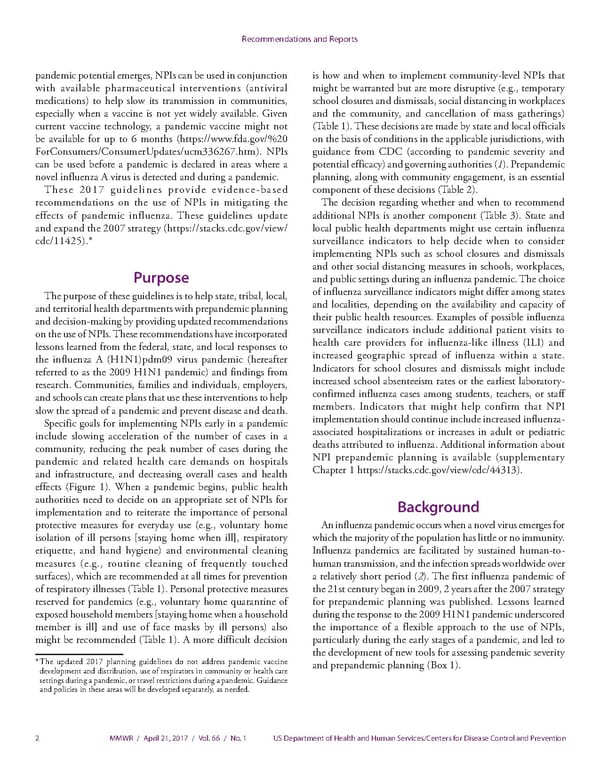Recommendations and Reports pandemic potential emerges, NPIs can be used in conjunction is how and when to implement community-level NPIs that with available pharmaceutical interventions (antiviral might be warranted but are more disruptive (e.g., temporary medications) to help slow its transmission in communities, school closures and dismissals, social distancing in workplaces especially when a vaccine is not yet widely available. Given and the community, and cancellation of mass gatherings) current vaccine technology, a pandemic vaccine might not (Table 1). These decisions are made by state and local officials be available for up to 6 months (https://www.fda.gov/%20 on the basis of conditions in the applicable jurisdictions, with ForConsumers/ConsumerUpdates/ucm336267.htm). NPIs guidance from CDC (according to pandemic severity and can be used before a pandemic is declared in areas where a potential efficacy) and governing authorities (1). Prepandemic novel influenza A virus is detected and during a pandemic. planning, along with community engagement, is an essential These 2017 guidelines provide evidence-based component of these decisions (Table 2). recommendations on the use of NPIs in mitigating the The decision regarding whether and when to recommend effects of pandemic influenza. These guidelines update additional NPIs is another component (Table 3). State and and expand the 2007 strategy (https://stacks.cdc.gov/view/ local public health departments might use certain influenza cdc/11425).* surveillance indicators to help decide when to consider implementing NPIs such as school closures and dismissals and other social distancing measures in schools, workplaces, Purpose and public settings during an influenza pandemic. The choice The purpose of these guidelines is to help state, tribal, local, of influenza surveillance indicators might differ among states and territorial health departments with prepandemic planning and localities, depending on the availability and capacity of and decision-making by providing updated recommendations their public health resources. Examples of possible influenza on the use of NPIs. These recommendations have incorporated surveillance indicators include additional patient visits to lessons learned from the federal, state, and local responses to health care providers for influenza-like illness (ILI) and the influenza A (H1N1)pdm09 virus pandemic (hereafter increased geographic spread of influenza within a state. referred to as the 2009 H1N1 pandemic) and findings from Indicators for school closures and dismissals might include research. Communities, families and individuals, employers, increased school absenteeism rates or the earliest laboratory- and schools can create plans that use these interventions to help confirmed influenza cases among students, teachers, or staff slow the spread of a pandemic and prevent disease and death. members. Indicators that might help confirm that NPI Specific goals for implementing NPIs early in a pandemic implementation should continue include increased influenza- include slowing acceleration of the number of cases in a associated hospitalizations or increases in adult or pediatric community, reducing the peak number of cases during the deaths attributed to influenza. Additional information about pandemic and related health care demands on hospitals NPI prepandemic planning is available (supplementary and infrastructure, and decreasing overall cases and health Chapter 1 https://stacks.cdc.gov/view/cdc/44313). effects (Figure 1). When a pandemic begins, public health authorities need to decide on an appropriate set of NPIs for Background implementation and to reiterate the importance of personal protective measures for everyday use (e.g., voluntary home An influenza pandemic occurs when a novel virus emerges for isolation of ill persons [staying home when ill], respiratory which the majority of the population has little or no immunity. etiquette, and hand hygiene) and environmental cleaning Influenza pandemics are facilitated by sustained human-to- measures (e.g., routine cleaning of frequently touched human transmission, and the infection spreads worldwide over surfaces), which are recommended at all times for prevention a relatively short period (2). The first influenza pandemic of of respiratory illnesses (Table 1). Personal protective measures the 21st century began in 2009, 2 years after the 2007 strategy reserved for pandemics (e.g., voluntary home quarantine of for prepandemic planning was published. Lessons learned exposed household members [staying home when a household during the response to the 2009 H1N1 pandemic underscored member is ill] and use of face masks by ill persons) also the importance of a flexible approach to the use of NPIs, might be recommended (Table 1). A more difficult decision particularly during the early stages of a pandemic, and led to the development of new tools for assessing pandemic severity * The updated 2017 planning guidelines do not address pandemic vaccine and prepandemic planning (Box 1). development and distribution, use of respirators in community or health care settings during a pandemic, or travel restrictions during a pandemic. Guidance and policies in these areas will be developed separately, as needed. 2 MMWR / April 21, 2017 / Vol. 66 / No. 1 US Department of Health and Human Services/Centers for Disease Control and Prevention
 Community Mitigation Guidelines to Prevent Pandemic Influenza Page 3 Page 5
Community Mitigation Guidelines to Prevent Pandemic Influenza Page 3 Page 5